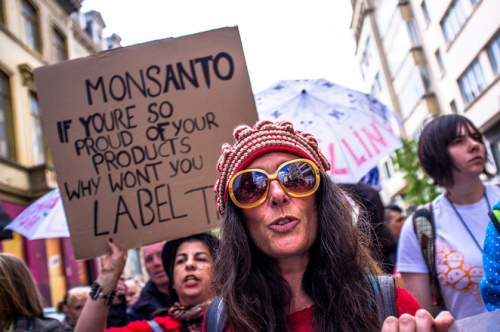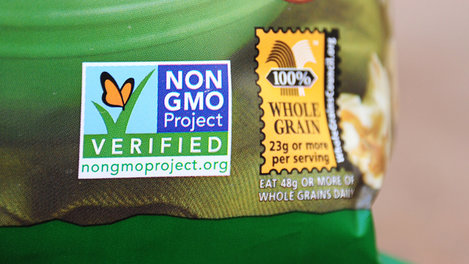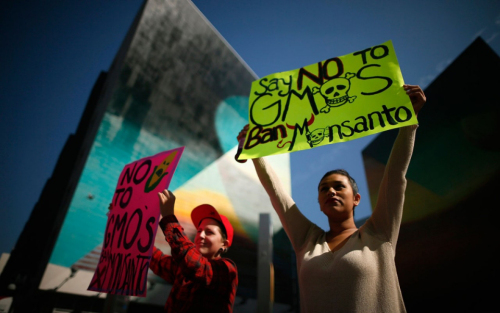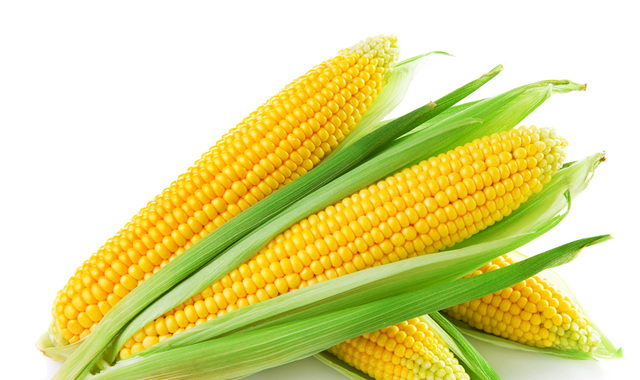
By Ronnie Cummins, April 24, 2014. Source: Huffington Post
After 20 years of battling Monsanto and corporate agribusiness, food and farm activists in Vermont, backed by a growing movement across the country, are on the verge of a monumental victory — mandatory labels on genetically engineered foods and a ban on the routine industry practice of labeling GMO-tainted foods as “natural.”
On April 16, 2014, the Vermont Senate passed H.112 by a vote of 28-2, following up on the passage of a similar bill in the Vermont House last year. The legislation, which requires all GMO foods sold in Vermont to be labeled by July 1, 2016, will now pass through a House/Senate conference committee before landing on Governor Peter Shumlin’s desk, for final approval.
Strictly speaking, Vermont’s H.112 applies only to Vermont. But it will have the same impact on the marketplace as a federal law. Because national food and beverage companies and supermarkets will not likely risk the ire of their customers by admitting that many of the foods and brands they are selling in Vermont are genetically engineered, and deceptively labeled as “natural” or “all natural” while simultaneously trying to conceal this fact in the other 49 states and North American markets. As a seed executive for Monsanto admitted 20 years ago, “If you put a label on genetically engineered food you might as well put a skull and crossbones on it.”
Proof of this “skull and crossbones” effect is evident in the European Union, where mandatory labeling, in effect since 1997, has all but driven genetically engineered foods and crops off the market. The only significant remaining GMOs in Europe today are imported grains (corn, soy, canola, cotton seed) primarily from the U.S., Canada, Brazil, and Argentina. These grains are used for animal feed, hidden from public view by the fact that meat, dairy and eggs derived from animals fed GMOs do not yet have to be labeled in the EU.
Given the imminent passage of the Vermont legislation and the growing strength of America’s anti-GMO and pro-organic movement, the Gene Giants — Monsanto, Dow, DuPont, Bayer, BASF, and Syngenta — and the Grocery Manufacturers Association (GMA), representing Big Food, find themselves in a difficult position. Early polls indicate that Oregon voters will likely pass a ballot initiative on Nov. 4, 2014, to require mandatory labeling of GMOs in Oregon. Meanwhile, momentum for labeling continues to gather speed in other states as well.
Connecticut and Maine have already passed GMO labeling laws, but these laws contain “trigger” clauses, which prevent them from going into effect until other states mandate labeling as well. Vermont’s law does not contain a “trigger” clause. As soon as the governor signs it, it will have the force of law.
Divisions Between Big Food and the Gene Giants
Given what appears to be the inevitable victory of the consumer right-to-know movement, some of the U.S.’s largest food companies have quietly begun distancing themselves from Monsanto and the genetic engineering lobby. General Mills, Post Foods, Chipotle, Whole Foods, Trader Joe’s and others have begun to make changes in their supply chains in order to eliminate GMOs in some or all of their products. Several hundred companies have enrolled in the Non-GMO Project so they can credibly market their products as GMO-free.
At least 30 members (10 percent of the total membership) of the GMA who contributed money to defeat Proposition 37 in California in November 2012, have held back on making further contributions to stop labeling initiatives in other states. Among the apparent defectors in the GMA ranks are: Mars, Unilever, Smithfield, Heinz, Sara Lee, Dole, Wrigley, and Mead Johnson. Under pressure from the Organic Consumers Association, Dr. Anthony Weil’s natural health and supplements company, Weil Lifestyle, pulled out of the GMA.
Meanwhile a number of the Gene Giants themselves, including Monsanto, appear to be slowly decreasing their investments in gene-spliced GMOs, while increasing their investments in more traditional, and less controversial, cross-breeding and hybrid seed sales. Still, don’t expect the Gene Giants to give up on the GMO seeds and crops already in production, especially Roundup Ready and Bt-spliced crops, nor those in the pipeline such as 2,4-D “Agent Orange” and Dicamba-resistant corn and soybeans, GE rice, and “RNA interference” crops such as non-browning apples, and fast-growing genetically engineered trees.
America’s giant food companies and their chemical industry allies understand the threat posed by truthful labeling of GMOs, pesticides, antibiotics, growth promoters and toxic chemicals. They understand full well that the GMO monocrops and factory farms that dominate U.S. agriculture not only pose serious health and environmental hazards, but represent a significant public relations liability as well.
This is why the food and GE giants are threatening to sue Vermont and any other state that dares to pass a GMO labeling bill, even though industry lawyers have no doubt informed them that they are unlikely to win in federal court.
This is also why corporate agribusiness is supporting “Ag Gag” state laws making it a crime to photograph or film on factory farms. Why they’re lobbying for state laws that take away the rights of counties and local communities to regulate agricultural practices. And why they’re supporting secret international trade agreements, such as the Trans-Pacific Partnership, and the Trans Atlantic Trade and Investment Partnership that will, among other provisions, enable multinational corporations to sue and eliminate state and local laws on matters such as GMOs, food safety, and country of origin labeling.
The bottom line is this: Corporate America’s current “business-as-usual” strategies are incompatible with consumers’ right to know, and communities’ and states’ rights to legislate.
Coca-Cola, Pepsi, General Mills, Kellogg’s, Campbell’s, Safeway, Del Monte, Nestlé, Unilever, ConAgra, Wal-Mart, and every food manufacturer with GMO-tainted brands, understand they’re not going to be able to label their products as “produced with genetic engineering,” or drop the use of the term “natural” on GMO-tainted products, only in Vermont, while refusing to do so in other states and international markets. This is why their powerful front group, the GMA, is frantically working in Washington, D.C., to lobby the FDA and the Congress to take away the right of states to require genetically engineered foods and food ingredients to be labeled, and to allow them to continue to label and advertise genetically engineered and chemically-laced foods as “natural” or “all natural.”
Industry’s Last Chance: Indentured Politicians
Conspiring with the GMA, Monsanto’s minions from both the Republican and Democratic parties in Congress, led by the notorious Koch brothers mouthpiece, Rep. Mike Pompeo (R-Kan.), introduced in early April in the House a GMA-scripted bill to outlaw mandatory state GMO labels and allow the continued use of “natural” or “all natural” product labels on a wide range of Frankenfoods and beverages.
The GMA’s federal offensive to prop up the dangerous and evermore unpopular technology of transgenic foods comes on the heels of two high-profile ballot initiative battles in California (2012), and Washington State (2013), where GMA members were forced to spend almost $70 million to narrowly defeat GMO labeling forces. The 15 largest contributors to stop GMO labeling in California and Washington include the following GMA members:
(1) Monsanto: $13,487,350
(2) Dupont: $9,280,159
(3) Pepsico: $4,837,966
(4) Coca-Cola: $3,210,851
(5) Nestlé: $2,989,806
(6) Bayer CropScience: $2,591,654
(7) Dow Agrosciences: $2,591,654
(8) BASF Plant Science: $2,500,000
(9) Kraft Foods (Mondolez International) $2,391,835
(10) General Mills: $2,099,570
(11) ConAgra Foods: $2,004,951
(12) Syngenta: $2,000,000
(13) Kellogg’s: $1,112,749
(14) Campbell Soup: $982,888
(15) Smucker Company: $904,977
The Fire Next Time
These “dirty tricks,” “dirty money” ballot initiative victories in California and Washington now ring hollow. If Congress or the FDA, prompted by these same companies, dare to stomp on states’ rights to require GMO labels on GMO food, if they dare to repress the rights of millions of consumers to know whether or not their food is genetically engineered, they run the very real risk of detonating an even larger and more vociferous grassroots rebellion, including massive boycotts and a concerted effort to throw “Monsanto’s Minions” out of Congress. The widespread furor last year over the so-called “Monsanto Protection Act,” surreptitiously appended to the Appropriations Bill, and then, after massive uproar, subsequently removed, is but a partial foreshadowing of the turmoil yet to come.
Likewise Congress or the FDA should think twice before legally sanctioning the patently outrageous practice of allowing companies to continue to label or advertise GMO or chemically tainted food as “natural” or “all natural.”
Given the fact that 80-90 percent of American consumers want genetically engineered foods to be labeled, as indicated by numerous polls over the last 10 years, and given the fact that it is obviously unethical and fraudulent to label or advertise GMO or heavily chemically processed foods as “natural,” even the FDA has so far declined to come to the rescue of Monsanto and Big Food. In the face of 65 so far largely successful national class-action lawsuits against food companies accused of fraudulently labeling their GMO or chemically-laced brands as “natural, “Big Food’s lawyers have asked the FDA to come to their aid. But so far, the FDA has declined to throw gasoline on the fire.
It’s clear why “profit at any cost” big business wants to keep consumers in the dark. They want to maximize their profits. The consumer, the environment, the climate be damned. But let’s review, for the record, why truthful food labeling is so important to us, the overwhelming majority of the people, and to future generations.
Here are three major, indeed life-or-death, issues that drive America’s new anti-GMO and pro-organic food movement:
(1) There is mounting, and indeed alarming, evidence that genetically engineered foods and crops, and the toxic pesticides, chemicals, and genetic constructs that accompany them, are hazardous. GMOs pose a mortal threat, not only to human and animal health, but also to the environment, biodiversity, the survival of small-scale family farms, and climate stability.
(2) Genetically engineered crops are the technological cornerstone and ideological rationale for our dominant, out-of-control system of industrial agriculture, factory farms, and highly processed junk food.America’s industrial food and farming system is literally destroying public health, the environment, soil fertility and climate stability. As we educate, boycott and mobilize, as we label and drive GMOs off the market, we simultaneously rip the mask off Big Food and chemical corporations, which will ultimately undermine industrial agriculture and speed up the “Great Transition” to a food and farming system that is organic, sustainable and climate stabilizing.
(3) Fraudulent “natural” labels confuse consumers and hold back the growth of true organic alternatives. Consumers are confused about the difference between conventional products marketed as “natural,” or “all natural”and those nutritionally and environmentally superior products that are “certified organic.” Recent polls indicate that many health- and green-minded consumers remain confused about the qualitative difference between products labeled or advertised as “natural,” versus those labeled as organic. Many believe that “natural” means “almost organic,” or that a natural product is even better than organic. Thanks to growing consumer awareness, and four decades of hard work, the organic community has built up a $35-billion “certified organic” food and products sector that prohibits the use of genetic engineering, irradiation, toxic pesticides, sewage sludge and chemical fertilizers. As impressive as this $35 billion Organic Alternative is, it remains overshadowed by the $80 billion in annual spending by consumers on products marketed as “natural.” Get rid of fraudulent “natural” labels on GMO and chemically tainted products, and organic sales will skyrocket.
With the passage of the Vermont GMO labeling law, after 20 years of struggle, it’s time to celebrate our common victory. But as we all know, the battle for a new food and farming system, and a sustainable future has just begun
















